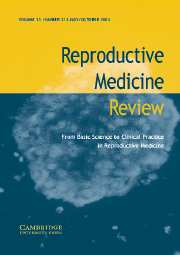Article contents
Unstimulated in vitro fertilization revisited
Published online by Cambridge University Press: 03 June 2009
Extract
The first attempts at in vitro fertilization (IVF) of human oocytes were performed during cycles utilizing human menopausal gonadotropin (hMG) and human chorionic gonadotropin (hCG). These early cycles resulted in a successful conception, which unfortunately ended as a tubal gestation. The birth of Louise Brown in 1978, the first successful IVF birth, was actually achieved following fertilization during a spontaneous cycle in which ovulation was triggered with endogenous luteinizing hormone (LH).However, due to the greater margin for error afforded by larger numbers of follicles, the practice of IVF rapidly evolved towards the use of controlled ovarian hyperstimulation (COH) to achieve higher pregnancy rates. It is easy to understand why this approach evolved. Oocyte harvesting was accomplished primarily by laparoscopy. Since oocyte yield per follicle was less than 100% and fertilization rates were limited, the relatively traumatic follicle aspiration process was more likely to result in embryo transfer if a greater number of follicles was present.
- Type
- Articles
- Information
- Copyright
- Copyright © Cambridge University Press 1996
References
- 3
- Cited by


